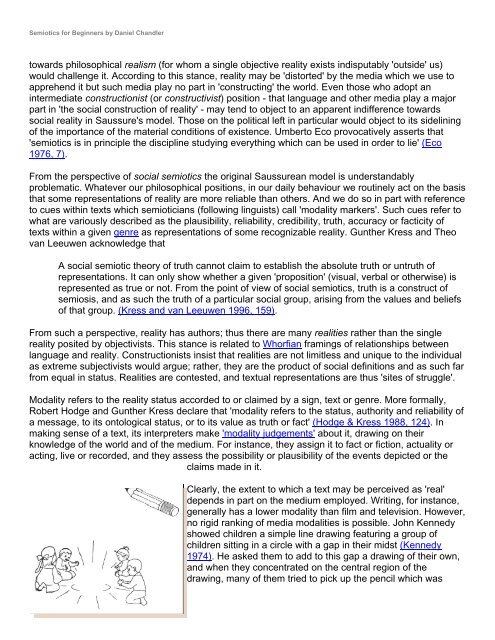Semiotics for Beginners by Daniel Chandler
Semiotics for Beginners by Daniel Chandler
Semiotics for Beginners by Daniel Chandler
Create successful ePaper yourself
Turn your PDF publications into a flip-book with our unique Google optimized e-Paper software.
<strong>Semiotics</strong> <strong>for</strong> <strong>Beginners</strong> <strong>by</strong> <strong>Daniel</strong> <strong>Chandler</strong><br />
towards philosophical realism (<strong>for</strong> whom a single objective reality exists indisputably 'outside' us)<br />
would challenge it. According to this stance, reality may be 'distorted' <strong>by</strong> the media which we use to<br />
apprehend it but such media play no part in 'constructing' the world. Even those who adopt an<br />
intermediate constructionist (or constructivist) position - that language and other media play a major<br />
part in 'the social construction of reality' - may tend to object to an apparent indifference towards<br />
social reality in Saussure's model. Those on the political left in particular would object to its sidelining<br />
of the importance of the material conditions of existence. Umberto Eco provocatively asserts that<br />
'semiotics is in principle the discipline studying everything which can be used in order to lie' (Eco<br />
1976, 7).<br />
From the perspective of social semiotics the original Saussurean model is understandably<br />
problematic. Whatever our philosophical positions, in our daily behaviour we routinely act on the basis<br />
that some representations of reality are more reliable than others. And we do so in part with reference<br />
to cues within texts which semioticians (following linguists) call 'modality markers'. Such cues refer to<br />
what are variously described as the plausibility, reliability, credibility, truth, accuracy or facticity of<br />
texts within a given genre as representations of some recognizable reality. Gunther Kress and Theo<br />
van Leeuwen acknowledge that<br />
A social semiotic theory of truth cannot claim to establish the absolute truth or untruth of<br />
representations. It can only show whether a given 'proposition' (visual, verbal or otherwise) is<br />
represented as true or not. From the point of view of social semiotics, truth is a construct of<br />
semiosis, and as such the truth of a particular social group, arising from the values and beliefs<br />
of that group. (Kress and van Leeuwen 1996, 159).<br />
From such a perspective, reality has authors; thus there are many realities rather than the single<br />
reality posited <strong>by</strong> objectivists. This stance is related to Whorfian framings of relationships between<br />
language and reality. Constructionists insist that realities are not limitless and unique to the individual<br />
as extreme subjectivists would argue; rather, they are the product of social definitions and as such far<br />
from equal in status. Realities are contested, and textual representations are thus 'sites of struggle'.<br />
Modality refers to the reality status accorded to or claimed <strong>by</strong> a sign, text or genre. More <strong>for</strong>mally,<br />
Robert Hodge and Gunther Kress declare that 'modality refers to the status, authority and reliability of<br />
a message, to its ontological status, or to its value as truth or fact' (Hodge & Kress 1988, 124). In<br />
making sense of a text, its interpreters make 'modality judgements' about it, drawing on their<br />
knowledge of the world and of the medium. For instance, they assign it to fact or fiction, actuality or<br />
acting, live or recorded, and they assess the possibility or plausibility of the events depicted or the<br />
claims made in it.<br />
Clearly, the extent to which a text may be perceived as 'real'<br />
depends in part on the medium employed. Writing, <strong>for</strong> instance,<br />
generally has a lower modality than film and television. However,<br />
no rigid ranking of media modalities is possible. John Kennedy<br />
showed children a simple line drawing featuring a group of<br />
children sitting in a circle with a gap in their midst (Kennedy<br />
1974). He asked them to add to this gap a drawing of their own,<br />
and when they concentrated on the central region of the<br />
drawing, many of them tried to pick up the pencil which was




